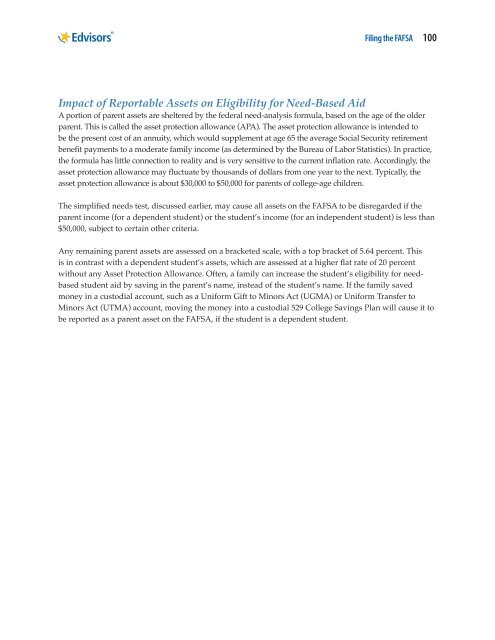filing-the-fafsa-2015-2016-edition
filing-the-fafsa-2015-2016-edition
filing-the-fafsa-2015-2016-edition
You also want an ePaper? Increase the reach of your titles
YUMPU automatically turns print PDFs into web optimized ePapers that Google loves.
Filing <strong>the</strong> FAFSA 100<br />
Impact of Reportable Assets on Eligibility for Need-Based Aid<br />
A portion of parent assets are sheltered by <strong>the</strong> federal need-analysis formula, based on <strong>the</strong> age of <strong>the</strong> older<br />
parent. This is called <strong>the</strong> asset protection allowance (APA). The asset protection allowance is intended to<br />
be <strong>the</strong> present cost of an annuity, which would supplement at age 65 <strong>the</strong> average Social Security retirement<br />
benefit payments to a moderate family income (as determined by <strong>the</strong> Bureau of Labor Statistics). In practice,<br />
<strong>the</strong> formula has little connection to reality and is very sensitive to <strong>the</strong> current inflation rate. Accordingly, <strong>the</strong><br />
asset protection allowance may fluctuate by thousands of dollars from one year to <strong>the</strong> next. Typically, <strong>the</strong><br />
asset protection allowance is about $30,000 to $50,000 for parents of college-age children.<br />
The simplified needs test, discussed earlier, may cause all assets on <strong>the</strong> FAFSA to be disregarded if <strong>the</strong><br />
parent income (for a dependent student) or <strong>the</strong> student’s income (for an independent student) is less than<br />
$50,000, subject to certain o<strong>the</strong>r criteria.<br />
Any remaining parent assets are assessed on a bracketed scale, with a top bracket of 5.64 percent. This<br />
is in contrast with a dependent student’s assets, which are assessed at a higher flat rate of 20 percent<br />
without any Asset Protection Allowance. Often, a family can increase <strong>the</strong> student’s eligibility for needbased<br />
student aid by saving in <strong>the</strong> parent’s name, instead of <strong>the</strong> student’s name. If <strong>the</strong> family saved<br />
money in a custodial account, such as a Uniform Gift to Minors Act (UGMA) or Uniform Transfer to<br />
Minors Act (UTMA) account, moving <strong>the</strong> money into a custodial 529 College Savings Plan will cause it to<br />
be reported as a parent asset on <strong>the</strong> FAFSA, if <strong>the</strong> student is a dependent student.


